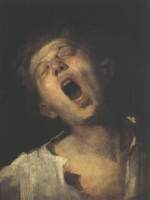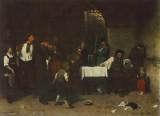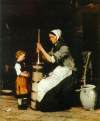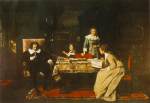

In spite of deficiencies at drawing and composition, works from his early period make beholders conscious of an ability characteristic of Munkácsy: he managed to unite pathos of historic painting with genre pictures of folk life. In 1863 when he arrived in Budapest, Telepy and Ligeti recognised his exceptional talent at once and helped him go to Vienna to learn there, and later in Munich. Then Munkácsy went to Düsseldorf where he painted Apprentice Yawning in 1869 (unfortunately, only a fragment survived), the first painting which manifests the characteristic style of Munkácsy.
 After the success it brought him, he painted Condemned Cell, his first great composition (1870), which summarises torture caused by oppression, moral uncertainty and reactions to an impending tragic end in visual form. Munkácsy was frightened by the sudden overwhelming success of the picture. He was anxious if he could raise the standard or even maintain it. This feeling of anguish was present all his career to be accompanied by his serious disease manifesting itself at a later stage of his life.
After the success it brought him, he painted Condemned Cell, his first great composition (1870), which summarises torture caused by oppression, moral uncertainty and reactions to an impending tragic end in visual form. Munkácsy was frightened by the sudden overwhelming success of the picture. He was anxious if he could raise the standard or even maintain it. This feeling of anguish was present all his career to be accompanied by his serious disease manifesting itself at a later stage of his life.
He settled down in Paris in 1871 for good and ever, and married a woman of higher rank than he was. From that time on he had an almost double life. Hardly had he finished Making Lint, a counterpart of Condemned Cell in many respects, but this time the subject matter was taken from the war between France and Germany, when he started painting large size pictures with dramatic atmosphere, e.g. Tramps at Night, and Pawnshop,  indicating that his interest was turned to dramatic figures of big cities who had not been painted previously. A series of pictures with two figures is particularly impressive, e.g. a version of Condemned Cell with two figures, Churning Woman, or Farewell.
indicating that his interest was turned to dramatic figures of big cities who had not been painted previously. A series of pictures with two figures is particularly impressive, e.g. a version of Condemned Cell with two figures, Churning Woman, or Farewell.
By that time Munkácsy had been in a state of ferment to search for novel ideas in art and decided with László Paál, a friend of his, to go to the village of Barbizon to paint landscapes. Some really magnificent works were painted in Barbizon, e.g. Carrying Brushwood, closely related to the series with two figures. As he worked in places other than Barbizon, landscapes accompanied him all his life, e.g. The Colpach Park, or Dusty Road which reflect a freedom of painting and airy vibrations of light flickering through dust indicating that Munkácsy had attained another artistic peak. Delicate still-lifes rich in colours and pompous decoration represent the same approach in a genre which became really popular in the early 20th century.
 Munkácsy's real strength, however, lay in character portrayal, e.g. large size compositions (Milton is Dictating Paradise Lost) or large size compositions on religious subjects (Christ before Pilate, Ecce Homo! 1896). Besides unparalleled beauty present in details, composition and style became superficial and more informal, genuine pathos which used to dominate previous works was no longer present. Due to campaigns of art trade, his pictures turned out to be huge social and financial success forcing Munkácsy to follow this path. He painted so-called salon pictures, too, i.e. scenes taking place in richly decorated interiors, e.g. Afternoon Visit, or genre pictures of the same fashion. Although Munkácsy's artistic qualities were still present, salon pictures put his image in an unfavourable light.
Munkácsy's real strength, however, lay in character portrayal, e.g. large size compositions (Milton is Dictating Paradise Lost) or large size compositions on religious subjects (Christ before Pilate, Ecce Homo! 1896). Besides unparalleled beauty present in details, composition and style became superficial and more informal, genuine pathos which used to dominate previous works was no longer present. Due to campaigns of art trade, his pictures turned out to be huge social and financial success forcing Munkácsy to follow this path. He painted so-called salon pictures, too, i.e. scenes taking place in richly decorated interiors, e.g. Afternoon Visit, or genre pictures of the same fashion. Although Munkácsy's artistic qualities were still present, salon pictures put his image in an unfavourable light.
Portraits of Franz Liszt at old age and Bishop Haynald clearly illustrate his sense of colours and character portrayal. At the end of his life when disease was demanding more and more of his energy and finally darkness descended on his mind, he accomplished two more pictures involving several figures, one being Strike (1896) where he illustrated the subject of the picture, rather unusual at his time, in a new style of character portrayal with the old passionate approach only superficially present but the composition proved to be less successful. The other work was The Conquest (Entrance of the Hungarians), a panneau for one of the session rooms in the Parliament, with which, however, he failed to revive historic painting.